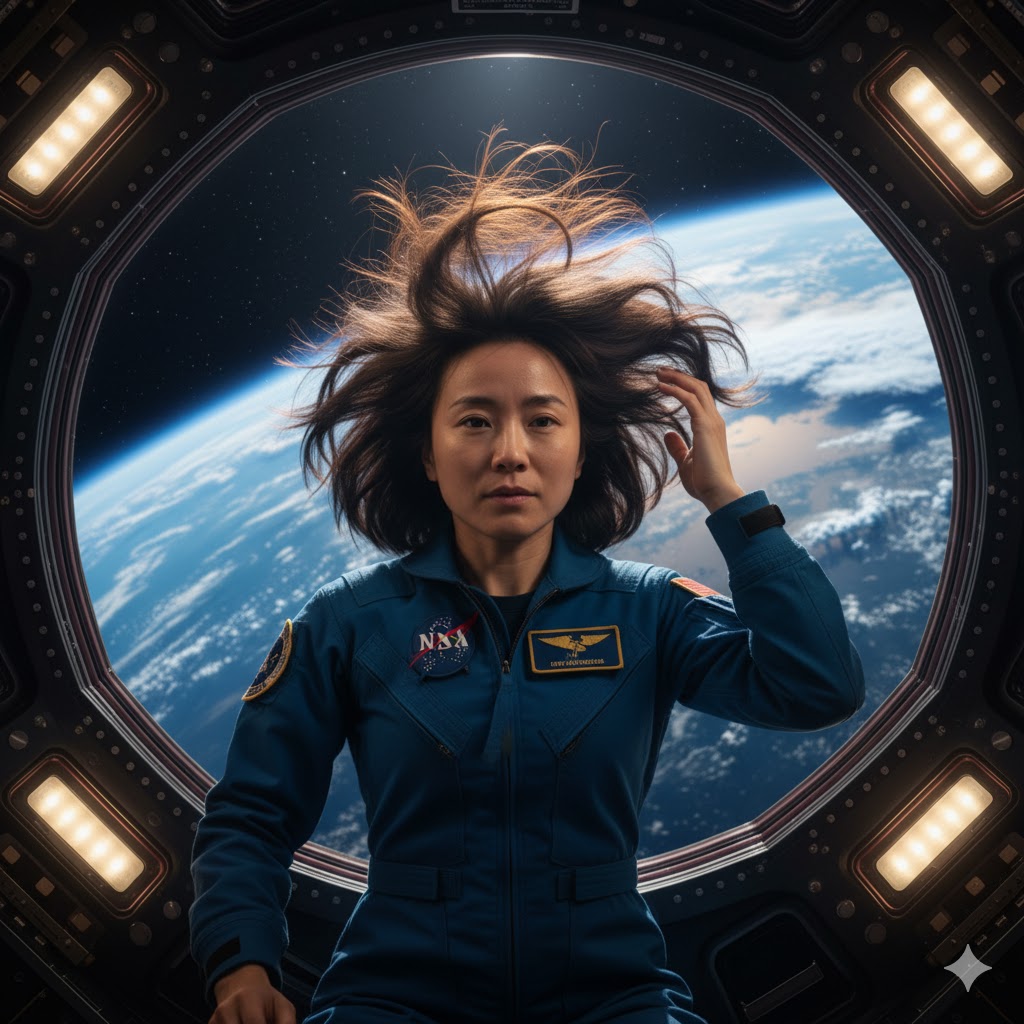When astronauts leave Earth, they face countless physiological changes — from muscle atrophy to bone density loss. But there’s another, lesser-known side effect of space travel that’s raising scientific curiosity: hair loss. The absence of gravity doesn’t just affect the body’s structure — it influences how blood flows, how nutrients circulate, and even how the scalp behaves.
At ZMD Hair, we explore hair science from every possible angle — including how the human body reacts in extreme environments. In this article, we’ll unpack what zero gravity reveals about scalp health, follicular function, and the future of hair restoration, both in orbit and here on Earth.
The Surprising Link Between Spaceflight and Hair Loss
Hair growth depends on three essential factors: circulation, hormonal balance, and cellular regeneration. All three are disrupted in space.
In zero gravity, blood and fluids shift toward the upper body and head, leading to what astronauts describe as “puffy face syndrome.” Ironically, this temporary swelling does not translate into better scalp circulation. Instead, the redistribution of fluids can impair nutrient delivery to the follicles and alter the scalp’s microenvironment, triggering hair shedding or slower growth cycles.
Additionally, extended space missions expose the body to radiation, stress, and altered sleep cycles — all of which have measurable effects on the anagen (growth) and telogen (resting) phases of hair.
What Microgravity Reveals About Circulation and the Scalp
On Earth, gravity plays a key role in blood flow distribution. It ensures that the lower extremities receive adequate circulation while the body’s upper regions maintain balance. In microgravity, however, that system is disrupted.
1. Reduced Nutrient Delivery to Follicles
Hair follicles rely on capillary blood flow to receive oxygen, amino acids, and essential vitamins. In space, the body’s circulatory efficiency drops, meaning follicles get fewer nutrients. This can lead to duller strands, slower regrowth, and premature shedding.
2. Altered Sebum Regulation
The scalp’s oil glands — which rely on hormonal signaling and mechanical stimulation — behave differently without gravity. Astronauts often report dryer or itchier scalps, suggesting that sebum production and distribution are affected. A compromised oil barrier can increase scalp inflammation and follicular stress.
3. Disrupted Mechanical Stimulation
On Earth, walking, movement, and posture shifts provide subtle stimulation that promotes healthy circulation to the scalp. In space, the absence of gravity and reduced mechanical tension may decrease microcirculation, slowing down follicular metabolism.
The Stress Factor: Cortisol in Orbit
Stress is a universal hair health disruptor — and spaceflight is one of the most stressful environments the human body can experience. Astronauts endure intense workloads, confinement, radiation exposure, and isolation — all of which elevate cortisol, the body’s primary stress hormone.
High cortisol levels:
- Constrict scalp blood vessels
- Shorten the growth phase of hair
- Increase shedding through telogen effluvium
A NASA study on space physiology confirmed elevated cortisol levels in astronauts after long-duration missions, reinforcing the connection between psychological stress and biological responses that impact the scalp.
At ZMD Hair, we frequently observe similar stress-related patterns in our Earth-bound patients — particularly those facing chronic anxiety, sleep deprivation, or high-performance pressure. The lessons learned from space research directly inform how we approach stress-induced hair loss on the ground.
Radiation and Follicular Damage
Outside the protection of Earth’s atmosphere, astronauts are exposed to cosmic radiation — a form of high-energy particle exposure that can damage cellular DNA, including the rapidly dividing cells in hair follicles.
Even low doses of ionizing radiation can trigger oxidative stress, leading to the breakdown of collagen, DNA mutations, and premature follicular aging. This may explain why astronauts returning from long missions occasionally show subtle signs of thinning or texture change in their hair.
For dermatologists and trichologists, studying these effects provides a model for understanding how environmental factors — pollution, UV exposure, and toxins — accelerate follicular decline on Earth.
Sleep, Circadian Rhythms, and Hair Growth
The human body’s circadian rhythm — its internal clock — controls countless biological processes, including hormone release and cellular repair. In space, with 16 sunrises and sunsets every 24 hours, circadian regulation becomes severely disrupted.
This impacts the melatonin cycle — a hormone that not only governs sleep but also influences hair follicle regeneration. Poor sleep quality can impair the anagen phase, resulting in brittle, weaker strands and increased shedding.
It’s the same principle ZMD Hair specialists emphasize for Earth-based patients: poor-quality rest equals poor-quality regrowth. The scalp, like every organ, heals and rebuilds most effectively during deep sleep cycles.
What Astronaut Studies Teach Us About Scalp Biology
NASA’s ongoing research into human adaptation to microgravity has inadvertently become a goldmine for understanding scalp physiology. Some of the most valuable insights include:
- Hair follicles are extremely sensitive to systemic changes in blood flow and hormonal signaling.
- Stress and inflammation disrupt the scalp’s immune balance, accelerating hair cycle disruption.
- Environmental changes — whether in orbit or urban life — alter the scalp’s microbiome and hydration levels.
These findings emphasize one truth: hair health reflects whole-body health. Whether in zero gravity or everyday gravity, follicles respond to the environment we create inside and outside the body.
Applying Space Science to Modern Hair Restoration
At ZMD Hair, we believe that what happens in space can inspire breakthroughs on Earth. By understanding how follicles behave under extreme conditions, we can better target the cellular mechanisms that promote regrowth and protection.
Our advanced treatments integrate these principles:
- PRP (Platelet-Rich Plasma) Therapy: Uses the body’s own growth factors to reactivate dormant follicles and enhance microcirculation — much like restoring “gravity” for your scalp.
- Low-Level Laser Therapy (LLLT): Promotes oxygenation and cell energy production, counteracting microgravity-like nutrient loss.
- Nutritional and Stress Analysis: Helps address internal imbalances that mimic the physiological strain experienced in spaceflight.
By merging clinical expertise with scientific insight, ZMD Hair offers comprehensive, evidence-based restoration that honors both biology and innovation.
Conclusion:
Space travel pushes human biology to its limits — and our hair is no exception. The challenges astronauts face in microgravity reveal fundamental truths about how circulation, stress, and hormonal balance shape scalp vitality.
At ZMD Hair, we take these lessons to heart. By applying space-derived insights to our treatment philosophy, we help patients restore scalp balance, strengthen follicular resilience, and promote lasting regrowth.
📞 Curious about how your scalp health reflects your body’s internal balance?
Visit ZMDHair.com or call today to schedule a private consultation.
Discover how science — from Earth to orbit — can help you reclaim your hair’s strength, vitality, and future.




